Beadazzled
Beads in all shapes and colours as well as bags, cheerfully decorated lamps and other accessories, bound to make most women greedy.
Amsterdam is a small city, and the majority of its residential outer districts are easily reached from the city centre. The south holds most of interest, kicking off with the vibrant De Pijp quarter, home to the Heineken Experience and the 1930s architecture of the Nieuw Zuid (New South), which is also near the enjoyable woodland area of the Amsterdamse Bos. As for the other districts, you’ll find a good deal less reason to make the effort, although the Tropenmuseum, a short walk from the Muiderpoort gate in Amsterdam East, is worth a special journey, and further south the Amsterdam ArenA, home to Ajax, is a must-see for football fans.
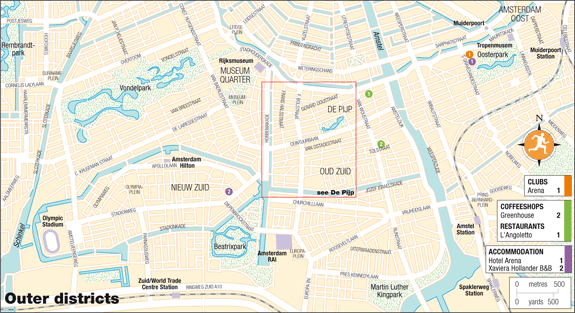
Across Boerenwetering, the canal to the east of the Rijksmuseum and the Museumplein, lies the busy heart of the Oud Zuid (Old South) – the district known as De Pijp (“The Pipe”), Amsterdam’s first real suburb. New development beyond the Singelgracht began around 1870, but after laying down the street plans, the city council left the actual house-building to private developers. They made the most of the arrangement and constructed long rows of cheaply built and largely featureless five- and six-storey buildings, and it is these that still dominate the area today. The district’s name comes from the characteristically narrow terraced streets running between long, sombre canyons of brick tenements: the apartments here were said to resemble pipe-drawers, since each had a tiny street frontage but extended deep into the building. De Pijp remains one of the city’s more closely knit communities, and is home to a large proportion of new arrivals – Surinamese, Moroccan, Turkish and Asian.
Trams #16 and #24, beginning at Centraal Station, travel along the northern part of De Pijp’s main drag, Ferdinand Bolstraat, as far as Albert Cuypstraat.
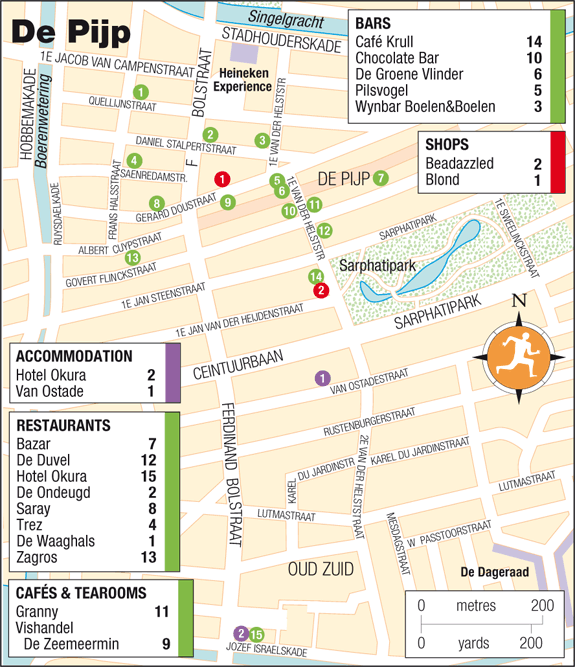
At the southern end of Vijzelgracht, on the city-centre side of the Singelgracht, is the Wetering circuit roundabout, which has two low-key memorials to World War II. On the southwestern corner of the roundabout, by the canal, is a sculpture of a wounded man holding a bugle; it was here, on March 12, 1945, that thirty people were shot by the Germans in reprisal for acts of sabotage by the Dutch Resistance – given that the war was all but over, it’s hard to imagine a crueller or more futile action. Across the main street, the second memorial in the form of a brick wall commemorates H.M. van Randwijk, a Resistance leader.
Stadhouderskade 78
![]() Tram #16, #24 from Centraal station
Tram #16, #24 from Centraal station
![]() 020/523 9666
020/523 9666
Daily 11am–7pm
€15
On the northern edge of De Pijp, just beyond the Wetering Circuit, the former Heineken brewery, a whopping modern building beside the Singelgracht canal, now holds the Heineken Experience. The brewery was Heineken’s headquarters from 1864 to 1988, when the company was restructured and brewing was moved to a location out of town. Since then, Heineken has developed the site as a tourist attraction with lots of gimmicky but fun attractions such as virtual reality tours and displays on the history of Heineken, from advertising campaigns to beer-making. The old brewing facilities with their vast copper vats are included on the tour, but for many the main draw is the free beer you get to quaff at the end in the bar.
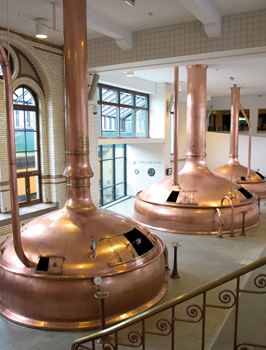
€7
Ferdinand Bolstraat, running north–south, is De Pijp’s main street, but the long east–west thoroughfare of Albert Cuypstraat is its heart. The general market here (daily except Sun 10am–5pm) – which stretches for over a kilometre between Ferdinand Bolstraat and Van Woustraat – is the largest in the city, with a huge array of stalls selling everything from carrots and raw-herring sandwiches to saucepans and Day Glo thongs. Check out the ethnic shops that flank the market on each side, and the good-value Indian and Surinamese restaurants down the side streets.
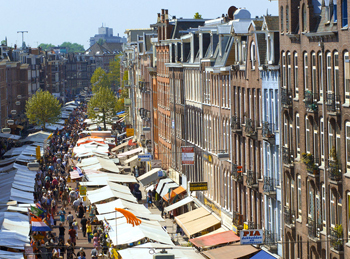
Tram #3 & 25
Leafy Sarphatipark provides a welcome splash of greenery among the surrounding brick and concrete. The park, complete with footpaths and a sinewy lake, was laid out before the construction of De Pijp got underway, and was initially intended as a place for the bourgeoisie to take a picnic.
Southwest of De Pijp, the Nieuw Zuid (New South) was the first properly planned extension to the city since the concentric canals of the seventeenth century. The Dutch architect Hendrik Petrus Berlage was responsible for the overall plan, but much of the implementation passed to a pair of prominent architects of the Amsterdam School, Michael de Klerk and Piet Kramer, and it’s the playful vision of these two – turrets and bulging windows, sloping roofs and frilly balustrades – that you see in some of the buildings of the Nieuw Zuid today. These architectural peccadilloes have helped make the Nieuw Zuid one of Amsterdam’s most sought-after addresses. The best example of the area’s style is the housing estate located just north of the Amstel canal, De Dageraad. Apollolaan and, a little way to the east, Churchilllaan, are especially favoured and home to some of the city’s most attractive properties. Locals pop to the shops on Beethovenstraat, the main drag running south right through the district, and stroll through the languid greenery of the Beatrixpark, or, slightly further out, the Amsterdamse Bos, but there’s not much to attract the visitor who isn’t a student of modern architecture.
Apollolaan 138
One historic footnote that might entice you this far south is the Amsterdam Hilton, where John Lennon and Yoko Ono staged their famous week-long “Bed-In” for peace in 1969. More recently the Hilton was the centre of Dutch media attention when Herman Brood – a Dutch singer, painter and professional junkie – committed suicide by jumping from the roof.
![]() Tram #4 runs along Van Woustraat; get off at Jozef Israelskade and it’s a 5min walk to De Dageraad.
Tram #4 runs along Van Woustraat; get off at Jozef Israelskade and it’s a 5min walk to De Dageraad.
Built between 1919 and 1922, the De Dageraad housing project was – indeed, is – public housing inspired by socialist utopianism, a grand vision built to elevate the working class, hence its name, “The Dawn”. The handsome brick and stone work of the Berlage Lyceum marks the start of De Dageraad, with 350 workers’ houses stretching beyond to either side of Pieter Lodewijk Takstraat and Burgemeester Tellegenstraat. The architects used a reinforced concrete frame as an underlay to each house, thus permitting folds, tucks and curves in the brick exteriors. Strong, angular doors, sloping roofs and turrets punctuate the facades, and you’ll find a corner tower at the end of every block – it’s stunning.
Main entrance near the visitor centre at the junction of Amstelveenseweg and Van Nijenrodeweg, 3km south of the west end of the Vondelpark. Trams #16 & #24 from Centraal Station and the Heineken Experience; it’s about 350m from the nearest tram stop to the east end of Bosbaan and the visitor centre.
With ten square kilometres of wooded parkland, the Amsterdamse Bos (Amsterdam Forest), to the southwest of the Nieuw Zuid, is the city’s largest open space. Planted during the 1930s, the park was a large-scale attempt to provide gainful work for the city’s unemployed. Originally a bleak area of flat and marshy fields, it combines a rural feel with that of a well-tended city park – and thus the “forest” tag is something of a misnomer.
In the north of the Bos, the Bosbaan is a kilometre-long dead-straight canal, popular for boating and swimming, and there are children’s playgrounds and spaces for various sports, including ice skating. There’s also a goat farm (mid-March to Oct daily except Tues 10am–5pm Nov to early March also closed on Mon 020/645 5034) and a nature reserve just to the south with bison and sheep. Canoes and pedaloes can be rented west of the Bosbaan at Grote Vijver (“big pond” April–Sept daily 10.30am–7.30pm 020/645 7831), or you can simply walk or jog your way around a choice of six clearly marked trails. The Bezoekerscentrum (visitor centre daily noon–5pm free 020/545 6100), at the main entrance to the Bos at Bosbaanweg 5, provides maps and information. There’s also a pancake house, Boerderij Meerzicht at the east of the Bosbaan at Koenenkade 56 (late Feb to Oct Tues–Sun 10am–7pm; Nov to mid-Feb Fri–Sun 10am–6pm 020/679 2744) and bike rental close by (April–Oct daily 10am–6pm 020/644 5473) – cycling being the best way of getting around.
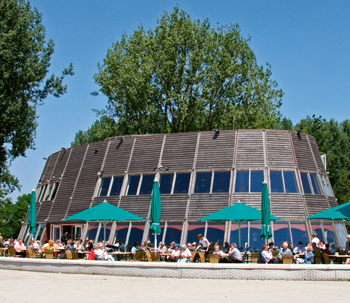
Sandbergplein 1, Amstelveen
![]() Bus #170, #171 and #172, stop ‘busstation Amstelveen’ in front of the museum.
Bus #170, #171 and #172, stop ‘busstation Amstelveen’ in front of the museum.
![]() 020/547 5050
020/547 5050
Tues–Sun 11am–5pm
€9.50
The CoBrA Museum of Modern Art, located well to the south of the Amsterdamse Bos entrance, close to the Amstelveen bus station, is soothingly white. Its glass walls give a view of the canal behind, displaying the works of the artists of the CoBrA movement, which was founded in 1948. The movement grew out of artistic developments in the cities of Copenhagen, Brussels and Amsterdam – hence the name. CoBrA’s first exhibition, held at Amsterdam’s Stedelijk Museum, showcased the big, colourful canvases, with bold lines and confident forms, for which the movement became famous. Their work displayed a spontaneity and inclusivity that was unusual for the art world of the time and it stirred a veritable hornet’s next of artistic controversy. You’ll only find a scattering of their work here in the gallery, but there’s enough to get an idea of what CoBrA were about, not least in Karel Appel’s weird bird sculpture outside, and the brash, childlike paintings of Appel inside – in many ways Appel was the movement’s leading light. Upstairs, the museum hosts regular temporary exhibitions of works by contemporary artists. There’s a good shop, too, with plenty of prints and books on the movement, plus a bright café where you can gaze upon Appel’s sculpture at length.
Plantage Middenlaan
Amsterdam East begins with Amsterdam’s old eastern gate, the Muiderpoort, a Neoclassical affair complete with a flashy cupola and grandiosely carved pediment. Napoleon staged a triumphal entry into the city through here in 1811, but his imperial pleasure was tempered by his half-starved troops, who could barely be restrained from helping themselves in a city of (what was to them) amazing luxury.
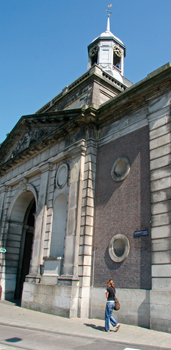
Linnaeusstraat 2
![]() Tram #9 from Centraal station
Tram #9 from Centraal station
![]() 020/568 8200
020/568 8200
Daily 10am–5pm
€9; 6- to 17-year-olds €5
Despite its general lack of appeal, the East district does have one obvious attraction – the Tropenmuseum, perched on the corner of another of the city’s municipal green spaces, the Oosterpark. With its cavernous central hall and three floors of gallery space, this museum has room to focus on themes such as the world’s cultural and historical influences, and impresses with its applied art.
The first floor is dedicated to Dutch colonialism, focusing on Indonesia and the Pacific. Among the artefacts, there are Javanese stone friezes, elaborate carved wooden boats from New Guinea and, perhaps strangest of all, ritual ancestor “Bis poles” cut from giant New Guinea mangroves. The collection is imaginatively presented and there are also creative and engaging displays devoted to such subjects as music-making and puppetry. In addition there are intriguing reconstructions, down to sounds and smells, of typical settings from different countries, such as a Jamaican café or a Surinamese logger’s hut.
While you’re here, be sure to try the inexpensive restaurant, the Ekeko, which serves tropical snacks and lunches, including popular national dishes from featured countries.
Arena Boulevard 1
![]() Metro to Strandvliet or Arena
Metro to Strandvliet or Arena
![]() 020/311 1336
020/311 1336
April–Sept daily 9am–6pm; Oct–March Mon–Sat & last Sun of the month 9am–5pm. Museum and stadium tour €10.50, museum only €3.50
It’s well worth the fifteen-minute metro ride to visit the Ajax Museum and take a tour of the stadium at the same time. The museum pays homage to Johan Marco Cruyff and van Basten and displays paraphernalia from the club’s European campaigns. The main draw, however, is an hour-long, behind-the-scenes tour.
Beads in all shapes and colours as well as bags, cheerfully decorated lamps and other accessories, bound to make most women greedy.
Popular gift shop with hand-painted and personalized pottery, bed linen, towels and note blocks, mainly in the colour pink.
Consistently sweeps the boards at the annual Cannabis Cup, with medals for its dope as well as “Best Coffeeshop” – these guys are extremely knowledgeable in their “grassy” field. Tolstraat is down to the south, but worth the trek: if you’re only buying once, buy here. Also a branch nearer to the centre at O.Z. Voorburgwal 191.
Just off the Albert Cuypstraat market, adorned with low-hanging beaded lamp-shades and faded photos of canal scenes, this place is known for its terrific appelgebak, had with whipped cream for that full-on homely experience.
What better way to round off your visit to the market than to sample the delights of this excellent – and typical – Dutch fish stall. If you’re not brave enough for the raw herring there are cooked offerings too, such as calamari.
Albert Cuypstraat 182
![]() 020/675 0544
020/675 0544
Mon–Thurs 5–11pm, Fri 5pm–midnight, Sat 4.30pm–midnight, Sun 4.30–11pm
This cavernous converted church is usually buzzing with activity long after the market traders have packed up. A lively place to eat dinner; choose from the Middle Eastern and North African influenced menu with tasty mezze and kebab.
Immensely popular eetcafé, always crowded, so be sure to book ahead. Mains like duck breast, saté and huge salads for around €16. Also a popular drinking spot after dinner.
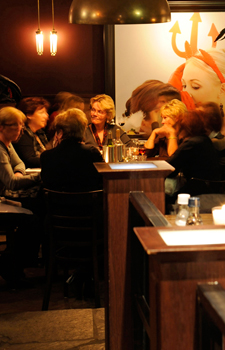
This five-star hotel has two Michelin-starred restaurants – the sushi restaurant Yamazato, with over fifty specialities, and the French Ciel Bleu situated on the 23rd floor, offering amazing views of the city – plus the renowned grill-plate restaurant Teppanyaki Sazanka, which makes it one of the finest places to dine in the city. Reckon on at least €50 per person. Advance bookings essential.
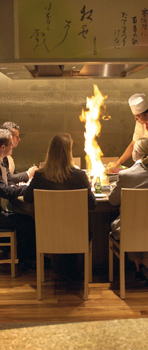
Just about everyone’s favourite Italian, inexpensive and always packed, with long wooden tables and benches that create a very sociable atmosphere. Not everything they serve is shown on the menu, so keep an eye on the glass showcase in front of the kitchen for any specials. No bookings, so just turn up and hope for the best.
A long time local favourite, presenting a French-oriented menu with the occasional Eastern twist. Prices are reasonable, with a decent boeuf bourguignon or dorade with lemon puree at around €18.
Excellent Turkish eatery down in the De Pijp neighbourhood. Its dark-wood, candle lit interior and living room ambience bestow an inviting backdrop for a leisurely dinner. It’s cheap too, with main courses from €12 and mixed mezze €7 per person.
Intimate little place, with good views of the chef cooking Mediterranean-inspired dishes in the open kitchen. Limited menu but very reasonably priced, with nothing exceeding €20. Three-course menu €27.50.
Well-prepared organic dishes in this cooperative-run restaurant near the Albert Cuyp. This place gets busy early so book ahead to be sure of a table. The menu changes twice a month, and though the food takes a while to prepare, the rewards are delicious and generously portioned. Mains around €15. No credit cards.
Popular no-frills Kurdish restaurant run by four brothers. Serves inexpensive traditional dishes from around €3.50 for starters and €13 for marinated lamb and chicken mains. Fish and vegetarian options available too.
On the corner of 1e van der Helststraat, a few metres from the Albert Cuyp, this is an atmospheric and lively place. Drinks and snacks all day long.
Cool, disco-inspired café-bar that’s open for tasty food or cocktails any time of the day. Perch at the bar on leather stools or lounge in the cosy room out the back. It’s a shame that service can be somewhat patchy.
Great views on the bustling market from this split-level café with cheap daily specials and bulky salads.
Favourite drinking spot for style-conscious 30-somethings, enjoying the laidback atmosphere and decent tapas as well as the good selection of Spanish wines.
Tasteful wine bar close to Albert Cuypstraat market with a huge selection of wines. A heated terrace provides alfresco eating even in the cooler months, and the French-inspired menu offers seafood delights such as a half-dozen oysters for €14.
’s-Gravensandestraat 51
![]() Metro to Weesperplein, then an 8min walk
Metro to Weesperplein, then an 8min walk
![]() 020/850 2400
020/850 2400
Fri & Sat 10/11pm–4am
Hip club set in a restored chapel adjoining a hotel that used to be an orphanage and an asylum. Open Fridays and Saturdays, with occasional Salsa nights and special parties hosted on a Sunday. International DJs sometimes drop by – and that’s when you can expect the entrance fee to jump from around €13 to €20.